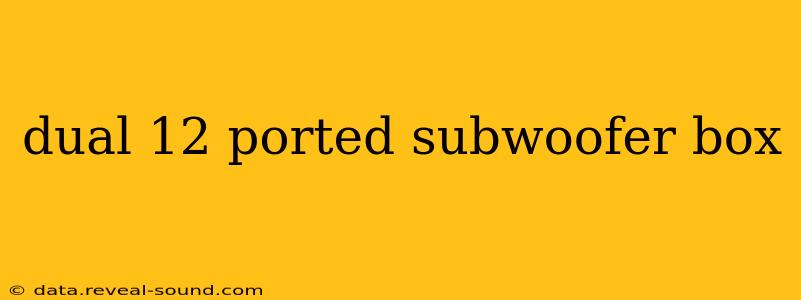Building a dual 12" ported subwoofer box is a rewarding project for audio enthusiasts seeking powerful, deep bass. This guide delves into the crucial design elements, helping you understand the science behind achieving optimal sound quality. We'll explore the factors influencing performance and answer frequently asked questions surrounding this popular subwoofer configuration.
What are the benefits of a dual 12" ported subwoofer box?
A dual 12" ported subwoofer box offers several key advantages over single subwoofer setups or sealed enclosures. Primarily, it delivers significantly increased output and lower frequency extension. Two 12-inch subwoofers working in concert provide more cone area, resulting in greater air displacement and a more powerful bass response. The ported design enhances this further by using the port (tube) to reinforce specific frequencies, creating a more pronounced and impactful bass. This makes it ideal for home theaters, car audio systems, or any application requiring substantial low-frequency energy. The increased output also allows for greater headroom, minimizing distortion at higher volumes.
What size port do I need for my dual 12" ported subwoofer box?
Determining the correct port size is crucial for optimal performance. An improperly sized port can lead to a weak or boomy response. The ideal port dimensions (length, width, and diameter) depend on several factors:
- Subwoofer parameters: The Thiele/Small (T/S) parameters of your specific subwoofer model are critical. These parameters, provided by the manufacturer, define the subwoofer's behavior within an enclosure. They include parameters like Vas (equivalent compliance), Qts (total Q factor), and Fs (resonant frequency).
- Box volume: The internal volume of the enclosure significantly impacts the tuning frequency and overall performance. The box volume needs to be calculated based on the subwoofer's T/S parameters and desired tuning frequency. Using a subwoofer box design software is highly recommended for accurate calculations.
- Tuning frequency: The tuning frequency (f3) is the frequency at which the port and subwoofer's resonance combine to produce maximum output. This frequency is often chosen based on personal preference and the desired bass response characteristics (e.g., deep, punchy, or extended). A lower tuning frequency will generally produce deeper bass, while a higher tuning frequency might emphasize punchier bass.
There's no single answer to the port size question; it's highly dependent on the specific subwoofer and desired tuning. Using a reputable subwoofer box design program (many are available online, some free and some paid) that takes your subwoofer's T/S parameters as input is essential for accurate port dimension calculation.
What is the best wood for a dual 12" ported subwoofer box?
While many materials can be used, denser hardwoods are generally preferred for subwoofer box construction due to their stiffness and ability to minimize unwanted resonances and vibrations. Popular choices include:
- Medium-Density Fiberboard (MDF): This is a very popular choice due to its density, affordability, and readily available sheets. It's readily machinable and provides excellent sound dampening.
- Birch Plywood: Offers excellent strength and stiffness, but is generally more expensive than MDF.
Regardless of your wood choice, ensuring the box is constructed rigidly and sealed properly is paramount to achieve the best sound quality. Internal bracing can further enhance stiffness and minimize vibrations.
How much power can a dual 12" ported subwoofer box handle?
The power handling capacity of your dual 12" ported subwoofer box depends on several factors:
- Subwoofer power handling: The individual power handling of the subwoofers themselves is the most critical limiting factor. Choose subwoofers rated to handle the amplifier's power output comfortably, leaving headroom to prevent damage.
- Amplifier power output: The power output of your amplifier shouldn't exceed the subwoofers' combined power handling capacity.
- Box design: The box itself shouldn't introduce any structural weaknesses that could be compromised by high power levels.
It's vital to choose components carefully and ensure they are appropriately matched to avoid damaging your equipment.
How do I choose the right subwoofers for a dual 12" ported box?
Choosing the right subwoofers involves considering factors beyond just the size. You'll need to examine their T/S parameters to ensure they are compatible with your chosen enclosure design and to choose a suitable tuning frequency. Consider also:
- Sensitivity: Higher sensitivity subwoofers require less power to produce the same sound pressure level (SPL), making them more efficient.
- Xmax (linear excursion): This parameter indicates how far the subwoofer cone can move linearly before distortion occurs. A higher Xmax is generally preferable for high-power applications.
By carefully considering these design aspects and employing appropriate design software, you can create a dual 12" ported subwoofer box capable of delivering deep, powerful, and distortion-free bass. Remember, accurate calculations and meticulous construction are key to achieving optimal performance.
